By Ryan Smith, Lead Guide
My original draw to Alaska brought me to McCarthy almost 4 years ago. With a classic case of “the more you know, the more there is to know,” my intrigue surrounding the landscape, the wilderness, and the mountains (of course) has only grown with each returning season. As an avid ski bum during the winters, it was always slightly painful to tell my friends and family of my Alaskan adventures that never involved the big Alaskan skiing you see in all the movies. That all changed this year when I was offered the chance to join Cody Simmons and Sam Spare (a.k.a. Boy Sam) on an adventure that would take us on a 14-day traverse through the pristine Alaskan wilderness and through the heart of the Wrangell Mountains – in the cold grip of winter! Our trip ideas changed multiple times, but we finally settled on a trip that would begin in McCarthy, end near Tok, and cover ~170 miles (274 km for my fellow Canadians).
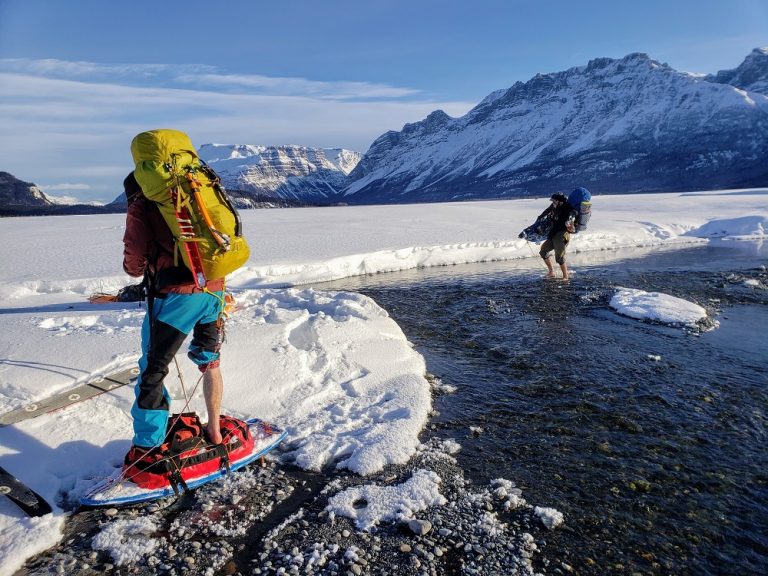
Even the packing process in McCarthy was cold. As three competitive guides (unwilling to show our weaknesses), we unknowingly challenged each other to bring fewer and fewer layers (to have lighter backpacks) and, before I knew it, I was traveling lighter than I do for summer trips! We brought a super lightweight tent as our shelter (a floorless mid) and were able to carry all our equipment and food by each carrying a backpack and pulling a sled.

Our 2 days spent working our way up the Nizina River were at a decent pace and went mostly smoothly. The meandering river braids always seemed to trap us against a cliff or send us into the bushes – resulting in a knee-deep channel that forced us to remove our boots and take about a minute and a half to cross while shouldering our packs and carrying our heavy sleds. We were officially past the point of no return! After surmounting the river’s challenges and marveling at the Mile High Cliffs from below, we skinned across the lake at the toe of the Nizina Glacier and through a maze of frozen icebergs. That was the moment the reality of our trip really hit me. I was in Alaska, skinning amongst the icebergs in the stillness of the frozen lake at the toe of the Nizina Glacier. Life was good!
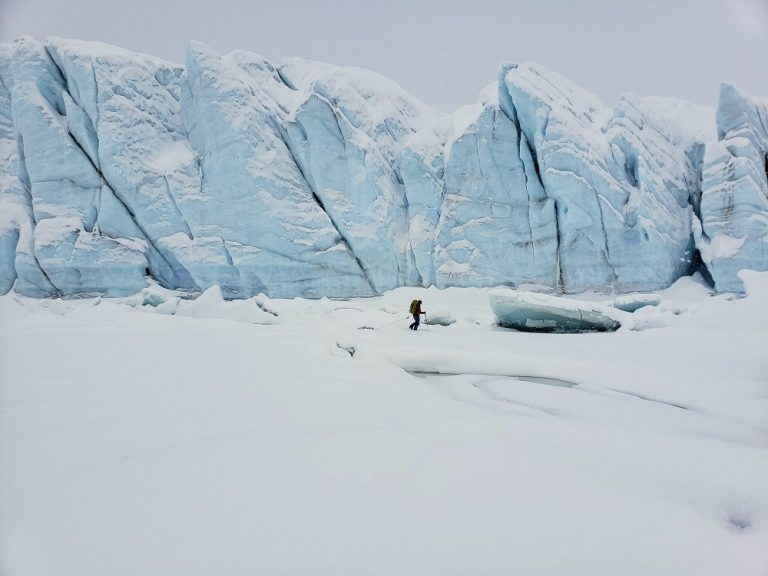 We struggled through the moraine of the Nizina Glacier as we picked our way through the undulating terrain. This was the moment we realized the impact pulling sleds would have on our trip. In stark contrast to the flat riverbed we’d been following, every time we traversed a slight slope on the moraine, the sleds would lazily flip over, requiring everyone to stop. Each time it would take a couple of tugs on the rope to pull it within arm’s reach and flip it back over – but three steps later it would be upside down again! The uncooperative sleds were wildly frustrating, but after we decided to name them Kip, Ronda, and Bernice so we had someone to get mad at, their personification made them more and more endearing to us, albeit no less difficult.
We struggled through the moraine of the Nizina Glacier as we picked our way through the undulating terrain. This was the moment we realized the impact pulling sleds would have on our trip. In stark contrast to the flat riverbed we’d been following, every time we traversed a slight slope on the moraine, the sleds would lazily flip over, requiring everyone to stop. Each time it would take a couple of tugs on the rope to pull it within arm’s reach and flip it back over – but three steps later it would be upside down again! The uncooperative sleds were wildly frustrating, but after we decided to name them Kip, Ronda, and Bernice so we had someone to get mad at, their personification made them more and more endearing to us, albeit no less difficult.
While making slow progress in whiteout conditions (making for challenging navigation), Sam was breaking trail while skiing down a small hill and broke his whippet when his sled pummeled him from behind. Although it was an easy fix, it was a good reminder that we had to survive with only what we were carrying, so it was extra important to take care of our gear! Before we knew it, we had crossed the heinous moraine and were making up our lost time by cruising up the Nizina Glacier, onto the Rohn Glacier, past Chimney Mountain, and up towards the head of the Chisana Glacier.
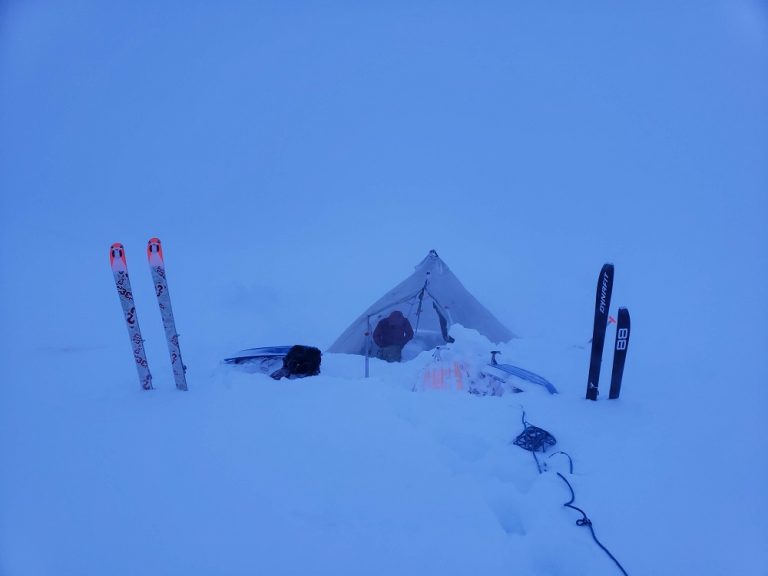
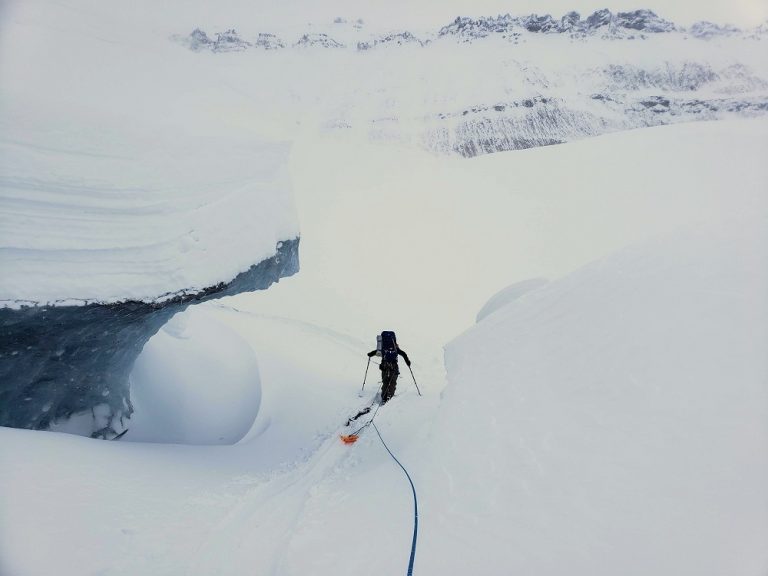 At this point, we had developed into quite a routine, walking by 8 am and only taking short breaks during the day to eat and drink water – stopping for more than 10 minutes would invite a chilling cold into your bones. Temperatures were consistently between 5 F (-15 C) and -13 F (-25 C) during the day, dropping only slightly at night thanks to the cloudy conditions that had plagued our travels so far. We had movable light until 6:30 pm and took advantage of every minute. Coming into camp, we divided up our roles (building a wall, setting up the mid, firing up the stoves) and all synchronized into a carefully choreographed dance (that was fine-tuned to the point of knowing exactly when it was your turn to “move into” the tent). We were able to squeeze the three of us into the mid, however, the condensation from our breaths and cooking would turn into ice on the inside of the tent and rain down onto us with every small breeze. As a result, our sleeping bags got wet and then froze to the point that there were audible cracks and crunches as we pulled them out of our backpacks each night. Doesn’t that just sound so cozy?
At this point, we had developed into quite a routine, walking by 8 am and only taking short breaks during the day to eat and drink water – stopping for more than 10 minutes would invite a chilling cold into your bones. Temperatures were consistently between 5 F (-15 C) and -13 F (-25 C) during the day, dropping only slightly at night thanks to the cloudy conditions that had plagued our travels so far. We had movable light until 6:30 pm and took advantage of every minute. Coming into camp, we divided up our roles (building a wall, setting up the mid, firing up the stoves) and all synchronized into a carefully choreographed dance (that was fine-tuned to the point of knowing exactly when it was your turn to “move into” the tent). We were able to squeeze the three of us into the mid, however, the condensation from our breaths and cooking would turn into ice on the inside of the tent and rain down onto us with every small breeze. As a result, our sleeping bags got wet and then froze to the point that there were audible cracks and crunches as we pulled them out of our backpacks each night. Doesn’t that just sound so cozy?
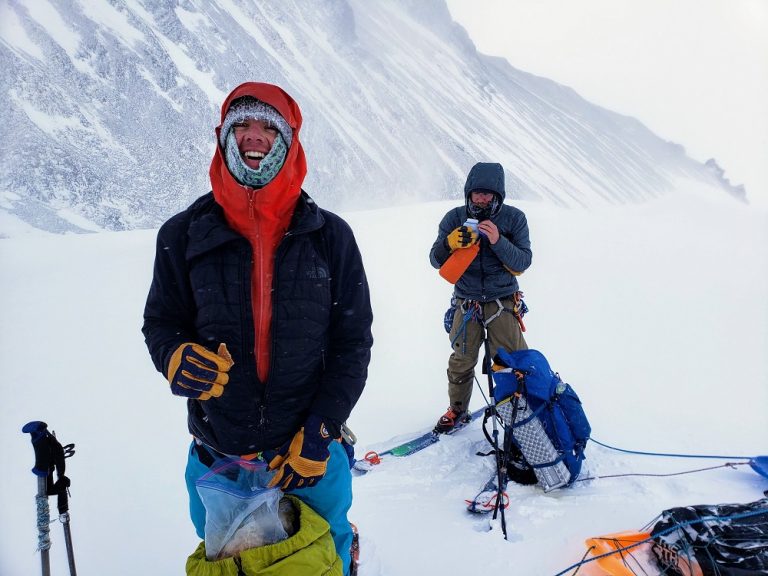 As an added bonus, my four-year-old inflatable sleeping pad, the only insulation between the cold snow and myself (as I had opted in the spirit of toughness not to bring a closed-cell pad), succumbed to the cold temps and ice and developed a hole – on the first night! Thanks to a combination of overboots, ropes, skins, and extra gloves, I was able to insulate myself enough from the ground, but I spent many hours staring enviously over at Cody and Sam who were sleeping soundly on their inflated mats which sat atop their closed-cell pads – the correct way to winter camp. I had realized my first major mistake – a tough lesson I was reminded about every night for the rest of the trip!
As an added bonus, my four-year-old inflatable sleeping pad, the only insulation between the cold snow and myself (as I had opted in the spirit of toughness not to bring a closed-cell pad), succumbed to the cold temps and ice and developed a hole – on the first night! Thanks to a combination of overboots, ropes, skins, and extra gloves, I was able to insulate myself enough from the ground, but I spent many hours staring enviously over at Cody and Sam who were sleeping soundly on their inflated mats which sat atop their closed-cell pads – the correct way to winter camp. I had realized my first major mistake – a tough lesson I was reminded about every night for the rest of the trip!
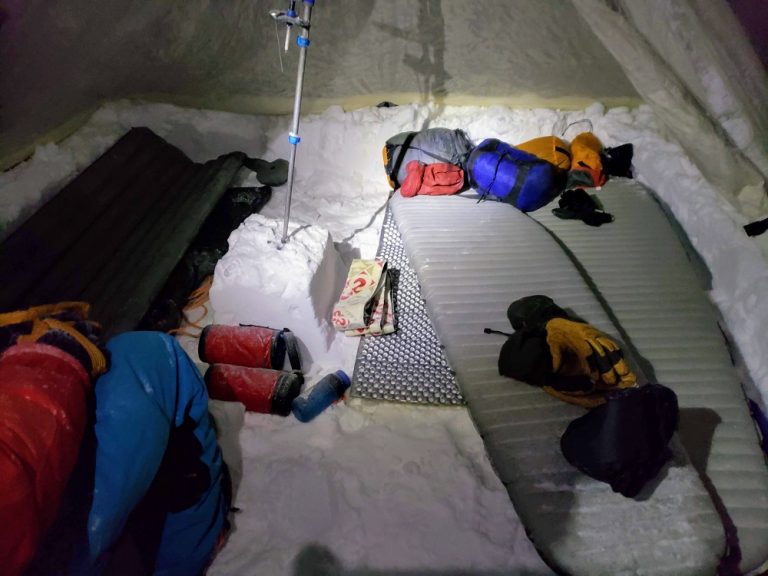 We had built some time into our itinerary (assuming cooperative weather) to climb some fun peaks around the Chisana area, but, as we climbed closer to 9,000 ft, the temps began to drop below -13 F (-25 C) and the winds picked up. We each silently decided that climbing any of the peaks was out of the question. We just wanted to get over the next pass and out of the cold and biting wind for the night. After a quick calculation using our temperature and windchill chart, we estimated the temperature to be pushing -60 F degrees (-51 C)! This was apparent when Cody’s nose and cheeks turned white, and Sam took a glove off while putting on his overboots and ended up with frostbite on the tips of two fingers – we call that type 2 fun! We were able to find a semi-protected area to dig deep into the snow and set up camp and appreciated the reminder that we were playing in a world where small mistakes have big consequences.
We had built some time into our itinerary (assuming cooperative weather) to climb some fun peaks around the Chisana area, but, as we climbed closer to 9,000 ft, the temps began to drop below -13 F (-25 C) and the winds picked up. We each silently decided that climbing any of the peaks was out of the question. We just wanted to get over the next pass and out of the cold and biting wind for the night. After a quick calculation using our temperature and windchill chart, we estimated the temperature to be pushing -60 F degrees (-51 C)! This was apparent when Cody’s nose and cheeks turned white, and Sam took a glove off while putting on his overboots and ended up with frostbite on the tips of two fingers – we call that type 2 fun! We were able to find a semi-protected area to dig deep into the snow and set up camp and appreciated the reminder that we were playing in a world where small mistakes have big consequences.
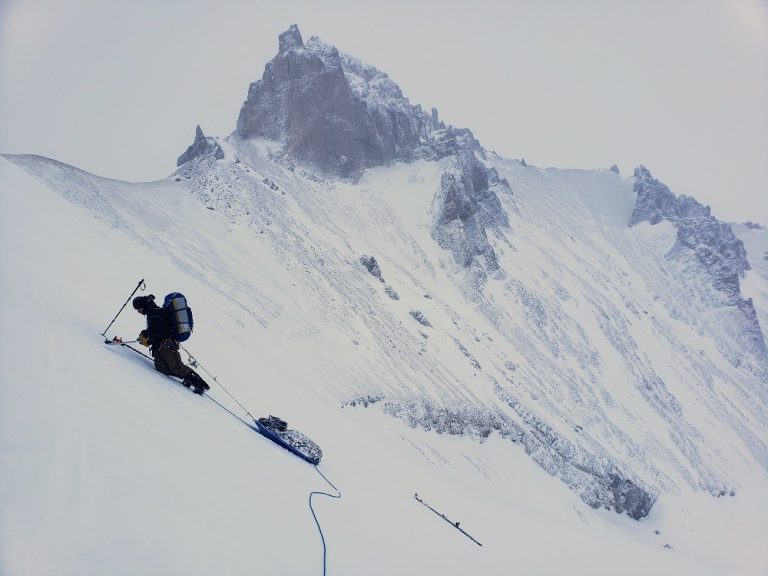 The next day we encountered whiteout conditions and a stubborn horizon line as we navigated the 9 mile (15 km) trek across the glacier through Chisana Pass, a major milestone of the trip. After 6 days fighting hard for every mile we gained, we finally got to rip off our climbing skins and ski downhill! We had been climbing since day 1 and it was time to finally reap the rewards by descending 3,500 ft of topo lines! We quietly skied through a black and white foreboding valley with impossibly tall, sheer walls covered with hard, blue alpine ice in every direction. It made a chill run down my spine – ominous but so enticing!
The next day we encountered whiteout conditions and a stubborn horizon line as we navigated the 9 mile (15 km) trek across the glacier through Chisana Pass, a major milestone of the trip. After 6 days fighting hard for every mile we gained, we finally got to rip off our climbing skins and ski downhill! We had been climbing since day 1 and it was time to finally reap the rewards by descending 3,500 ft of topo lines! We quietly skied through a black and white foreboding valley with impossibly tall, sheer walls covered with hard, blue alpine ice in every direction. It made a chill run down my spine – ominous but so enticing!
We worked our way down the glacier and the waxing moon lit up the clearing sky and turned it into a rather enjoyable experience! We admired the stars as we stopped to set up camp and began to notice the temperatures that accompany clear winter nights! The thermometer sank below -22 F (-30 C) and, by morning, we clocked our coldest ambient temperature yet, -26 F (-32C)!

The next day stands out as one of the most challenging ones of the trip. We got beat down. A few minutes out of camp, Sam slid down some moraine and into a creek and had to take off at full steam to keep his body temperature up. I added more tape to the blisters on my feet, neglecting to notice my climbing skins soaking in the glacier overflow (slush that hides just below a thin layer of ice or snow). And Cody was busy strapping a snow picket to the bottom of his ski pole to gain traction since the bottom tip had broken off earlier on the trip. We were all managing our own little problems but were naively comforted by the optimism that the meltwater channel we were headed towards was going to be “cruiser.” However, that was far from the truth. While it was spectacular, no matter how we navigated between the glacier, bedrock, and moraine, it seemed we could never go more than 100 yards before being thwarted by another obstacle. Overall, the navigation was tough, the sleds were uncooperative, it was bitingly cold, and we had all stepped in overflow ice numerous times. After an incredibly hard-fought 11 miles over 13 hours, we exhaustedly set up camp as the thermometer sunk to -35 F (-37 C).
Over the course of the trip, we developed a good feel for what happened to your equipment at various temperatures. For example, by -15 F, your breath would begin to freeze to your jacket. At -30 F, the stoves would stop working (the fuel and pumps are too cold). This night, we discovered the necessity of sleeping with your fuel bottle inside your sleeping bag. Although we went to bed hungry, the fuel warmed up by 1:30 am and we had hot meals, hot drinks, and hot soup by 2:30 am to fill our empty bellies! This led to an uptick in our group morale.
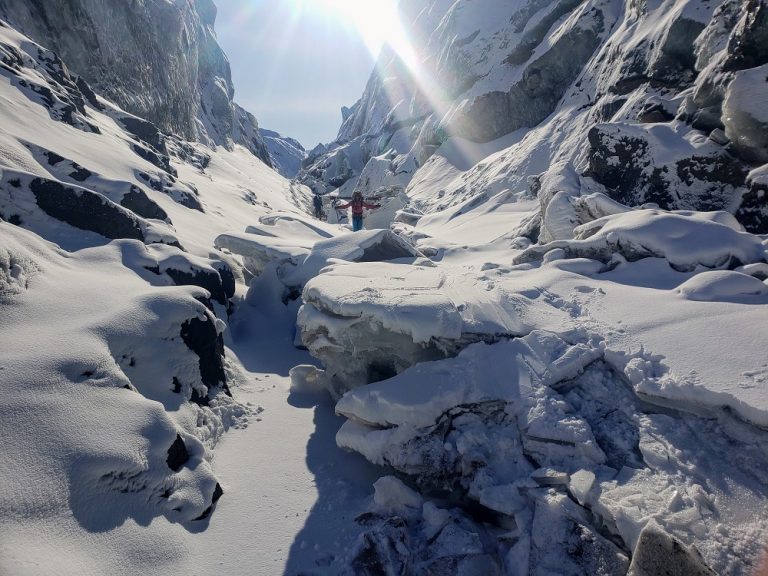
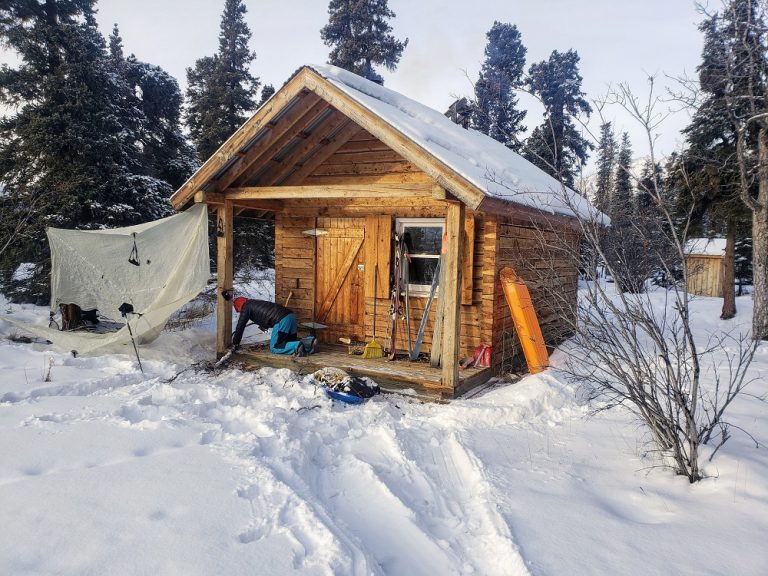 In actuality, a major spike in morale was only 5 miles away. We had pushed on that day in hopes of reaching the National Park Service’s Orange Hill Cabin but fell 5 miles short (and were rewarded with a chilly night and malfunctioning stoves). Rallying to thoughts of fire, warm and dry equipment, and a bed out of the snow, we pushed on to the cabin the next day, and it was everything we had dreamed of. At the cabin, amidst drying out everything we owned, Sam discovered that his feet were badly frostbitten (which is why he couldn’t feel them earlier in the day). Combining that with his frostbitten fingers, he made the decision to fly out to avoid re-freezing anything during the last 70 miles of the trip. Now armed with enough food for three people for 6 days and our feet wrapped in enough tape to probably not even need the ski boots, Cody and I left the comfort of the Orange Hill Cabin and headed north following the Nabesna River.
In actuality, a major spike in morale was only 5 miles away. We had pushed on that day in hopes of reaching the National Park Service’s Orange Hill Cabin but fell 5 miles short (and were rewarded with a chilly night and malfunctioning stoves). Rallying to thoughts of fire, warm and dry equipment, and a bed out of the snow, we pushed on to the cabin the next day, and it was everything we had dreamed of. At the cabin, amidst drying out everything we owned, Sam discovered that his feet were badly frostbitten (which is why he couldn’t feel them earlier in the day). Combining that with his frostbitten fingers, he made the decision to fly out to avoid re-freezing anything during the last 70 miles of the trip. Now armed with enough food for three people for 6 days and our feet wrapped in enough tape to probably not even need the ski boots, Cody and I left the comfort of the Orange Hill Cabin and headed north following the Nabesna River.
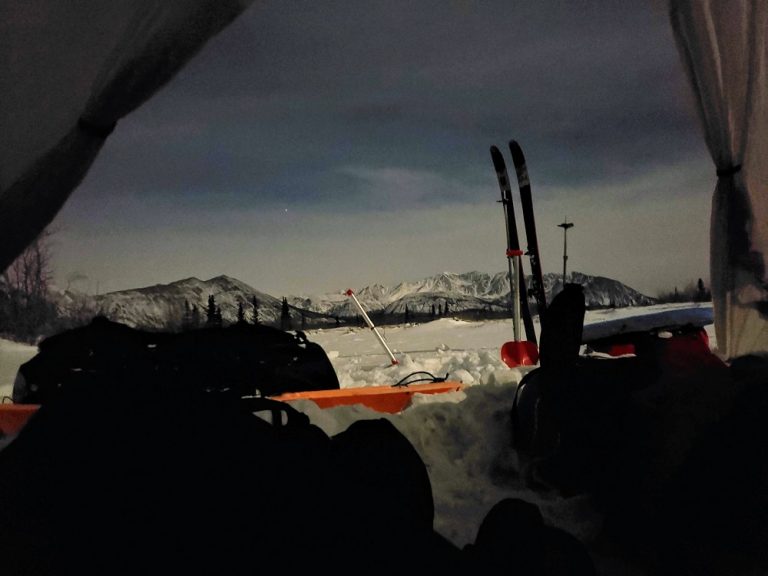 We didn’t want to tell Sam, but that was the turning point of the trip – travel became easy! We covered 12 miles in only 5 hours the day Sam left and set up camp under a full moon. The temperature was pushing -13 F (-25 C) but, after the bone-chilling temps of the previous nights, it felt so balmy we decided to sleep with the mid door open! Plus, now we were equipped with dry sleeping bags, dry sleeping pads, and what felt like more space than we knew what to do with (it felt like we were winter glamping!). To top it all off, we ended up splitting Sam’s left behind meals as an appetizer before ravenously inhaling both our own meals!
We didn’t want to tell Sam, but that was the turning point of the trip – travel became easy! We covered 12 miles in only 5 hours the day Sam left and set up camp under a full moon. The temperature was pushing -13 F (-25 C) but, after the bone-chilling temps of the previous nights, it felt so balmy we decided to sleep with the mid door open! Plus, now we were equipped with dry sleeping bags, dry sleeping pads, and what felt like more space than we knew what to do with (it felt like we were winter glamping!). To top it all off, we ended up splitting Sam’s left behind meals as an appetizer before ravenously inhaling both our own meals!
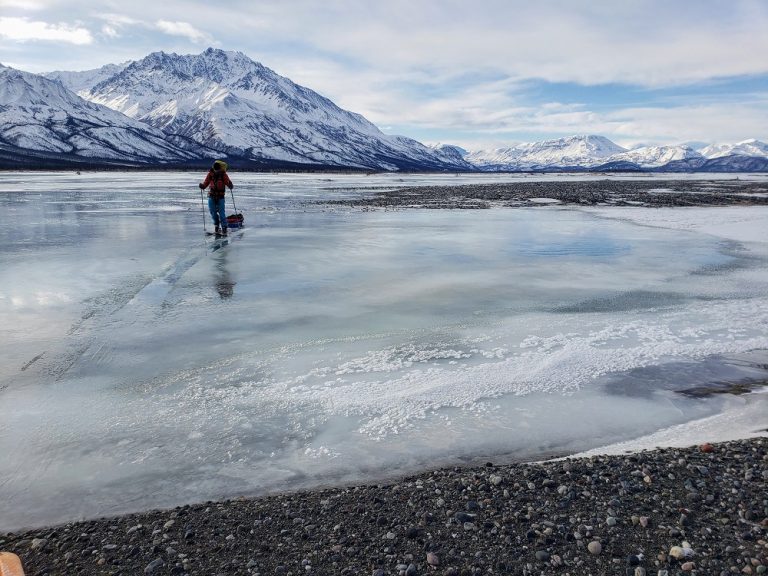 We worked our way down the Nabesna River, which was beautiful country and had completely frozen channels that made for fast travel. However, after a couple of close call slips on the clean sheets of ice, we were excited to have our skis on snow again as we began to head up Platinum Creek and through the Mentasta Mountains. As we pushed further up the creek through the Tetlin River headwaters, under Noyes Mountain, and down into the Little Tok River, the overlying snow got deeper and deeper, and the facets (sugar snow) became heavier and heavier. It was so deep that I occasionally broke through the snow with my skis on, and ended up sinking up to my knees – and I still had the anchor of a sled that I was dragging behind me constantly pulling and tugging me backward by the straps of my backpack! It was a slow slog that utilized every muscle in our bodies to make any forward progress. However, we were motivated by podcasts and dreaming of what kind of pizzas we were going to stuff ourselves with at the Moose’s Tooth in Anchorage.
We worked our way down the Nabesna River, which was beautiful country and had completely frozen channels that made for fast travel. However, after a couple of close call slips on the clean sheets of ice, we were excited to have our skis on snow again as we began to head up Platinum Creek and through the Mentasta Mountains. As we pushed further up the creek through the Tetlin River headwaters, under Noyes Mountain, and down into the Little Tok River, the overlying snow got deeper and deeper, and the facets (sugar snow) became heavier and heavier. It was so deep that I occasionally broke through the snow with my skis on, and ended up sinking up to my knees – and I still had the anchor of a sled that I was dragging behind me constantly pulling and tugging me backward by the straps of my backpack! It was a slow slog that utilized every muscle in our bodies to make any forward progress. However, we were motivated by podcasts and dreaming of what kind of pizzas we were going to stuff ourselves with at the Moose’s Tooth in Anchorage.
 We worked our way down the Nabesna River, which was beautiful country and had completely frozen channels that made for fast travel. However, after a couple of close call slips on the clean sheets of ice, we were excited to have our skis on snow again as we began to head up Platinum Creek and through the Mentasta Mountains. As we pushed further up the creek through the Tetlin River headwaters, under Noyes Mountain, and down into the Little Tok River, the overlying snow got deeper and deeper, and the facets (sugar snow) became heavier and heavier. It was so deep that I occasionally broke through the snow with my skis on, and ended up sinking up to my knees – and I still had the anchor of a sled that I was dragging behind me constantly pulling and tugging me backward by the straps of my backpack! It was a slow slog that utilized every muscle in our bodies to make any forward progress. However, we were motivated by podcasts and dreaming of what kind of pizzas we were going to stuff ourselves with at the Moose’s Tooth in Anchorage.
We worked our way down the Nabesna River, which was beautiful country and had completely frozen channels that made for fast travel. However, after a couple of close call slips on the clean sheets of ice, we were excited to have our skis on snow again as we began to head up Platinum Creek and through the Mentasta Mountains. As we pushed further up the creek through the Tetlin River headwaters, under Noyes Mountain, and down into the Little Tok River, the overlying snow got deeper and deeper, and the facets (sugar snow) became heavier and heavier. It was so deep that I occasionally broke through the snow with my skis on, and ended up sinking up to my knees – and I still had the anchor of a sled that I was dragging behind me constantly pulling and tugging me backward by the straps of my backpack! It was a slow slog that utilized every muscle in our bodies to make any forward progress. However, we were motivated by podcasts and dreaming of what kind of pizzas we were going to stuff ourselves with at the Moose’s Tooth in Anchorage.
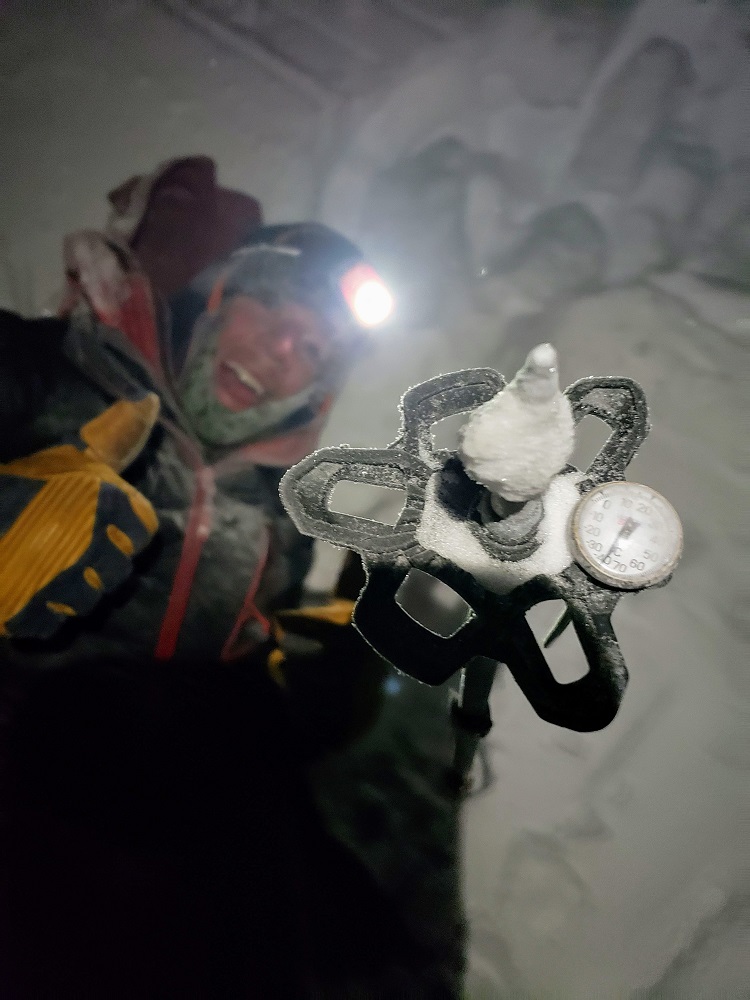 A little sleep deprived but alive, we rose at 5:00 am to ensure an early start and a hopeful exit. We also had another exciting surprise as the thermometer finally read -40 F (-40 C)! We were honestly relieved that we finally hit the -40 mark. There was something about -37 F (-38.5 C) that just didn’t have the same ring to it! We didn’t bother trying to get the stove working that morning – just get up and go! Putting our ski boots on seemed easier than it had in the past, our cold fingers seemed to handle every task with more dexterity than usual. Even our backpacks seemed to accept all our frozen gear with a sense of ease. Maybe we were finally toughening up?
A little sleep deprived but alive, we rose at 5:00 am to ensure an early start and a hopeful exit. We also had another exciting surprise as the thermometer finally read -40 F (-40 C)! We were honestly relieved that we finally hit the -40 mark. There was something about -37 F (-38.5 C) that just didn’t have the same ring to it! We didn’t bother trying to get the stove working that morning – just get up and go! Putting our ski boots on seemed easier than it had in the past, our cold fingers seemed to handle every task with more dexterity than usual. Even our backpacks seemed to accept all our frozen gear with a sense of ease. Maybe we were finally toughening up?
We were on the move shortly after 6 am but were quickly bogged down with more difficult stretches of deep trail breaking. However, in the afternoon we had a morale boost as we enjoyed following big wolf prints down the river. As we stopped to take a photo of the unusually fresh-looking prints, we saw two grey wolves dart off into the woods about 100 feet away. As we rounded the river bend, we saw the fresh moose kill they had been snacking on. We kept our distance as we passed the fresh kill knowing that at least two wolves were watching us from the cover of the woods. What an eerie feeling!
With 2 miles remaining, the Little Tok River tried to crush our spirits one last time by sucking us into a hidden slushy overflow tragedy that soaked our skins and froze our skis. Only 2 miles left! We ripped our skins, banged off the ice, and kept going. We pushed through, thinking about all the setbacks, challenges, beauty, hardships, frigid temps, peace and silence, exhaustion, frostbite, camaraderie, and miles of relentless slogging until we eventually reached the road where Sam was waiting for us with chips and beer. We had done it.
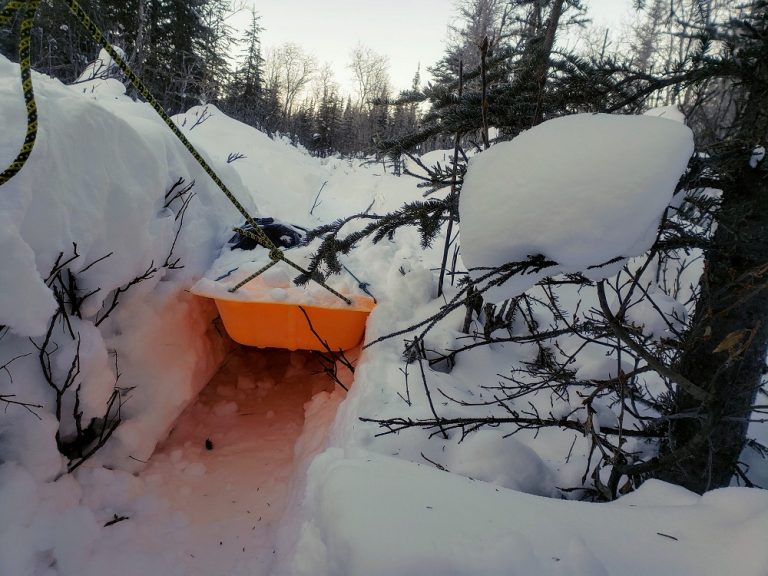
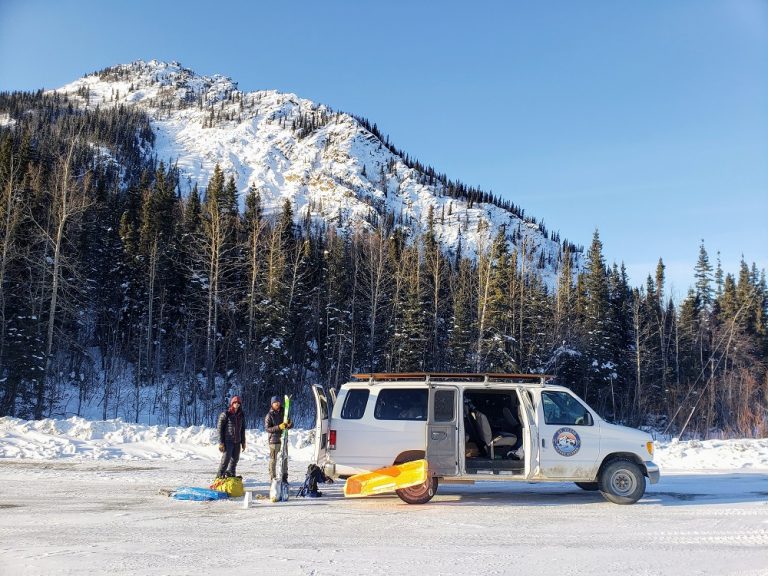 It was one heck of a journey that I don’t think we’ll forget any time soon. How wonderful to get to visit the Wrangell Mountains in the heart of winter and witness true nature undisturbed by man….and will probably remain undisturbed by this man for a while! Looking back at the moments of self-doubt, physical and emotional exhaustion, and the taxing mental aspect, it’s really the brief moments when we step back during hardships to indulge and appreciate the pure magnificence of our surroundings that become so memorable. I think that’s why we keep returning. That and the pictures always look so cool! Then, before you know it, you’re calling up your buddies because you’ve psyched yourself up for another trip and it’s not until your sleeping pad deflates on the first night that all the other memories come flooding back – but by then it’s too late! And the cycle starts over. That being said, I will for sure be back to the Wrangells for another adventure during the great Alaskan winters because, after all, I still can’t tell my friends or family I’ve skied a big Alaskan line!
It was one heck of a journey that I don’t think we’ll forget any time soon. How wonderful to get to visit the Wrangell Mountains in the heart of winter and witness true nature undisturbed by man….and will probably remain undisturbed by this man for a while! Looking back at the moments of self-doubt, physical and emotional exhaustion, and the taxing mental aspect, it’s really the brief moments when we step back during hardships to indulge and appreciate the pure magnificence of our surroundings that become so memorable. I think that’s why we keep returning. That and the pictures always look so cool! Then, before you know it, you’re calling up your buddies because you’ve psyched yourself up for another trip and it’s not until your sleeping pad deflates on the first night that all the other memories come flooding back – but by then it’s too late! And the cycle starts over. That being said, I will for sure be back to the Wrangells for another adventure during the great Alaskan winters because, after all, I still can’t tell my friends or family I’ve skied a big Alaskan line!